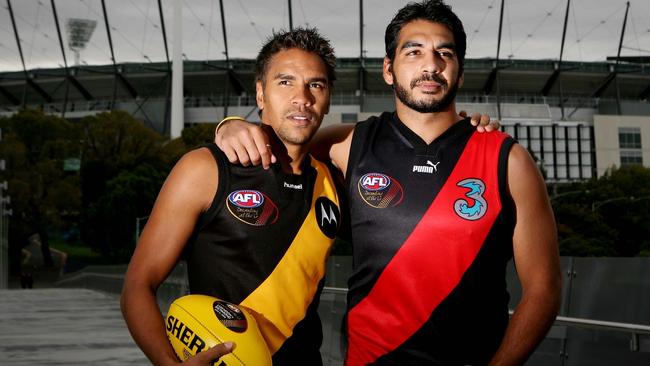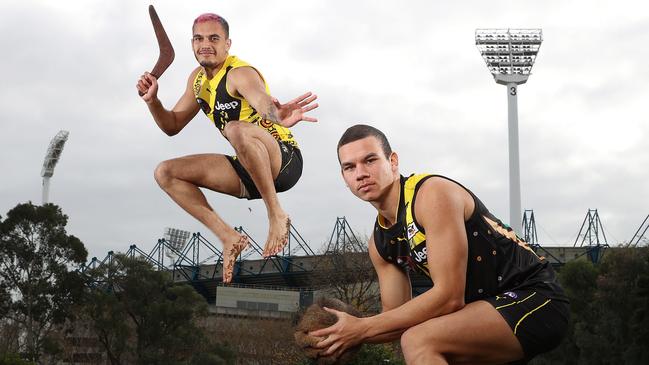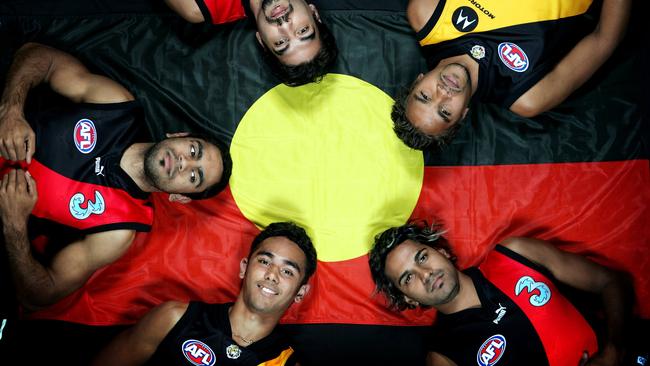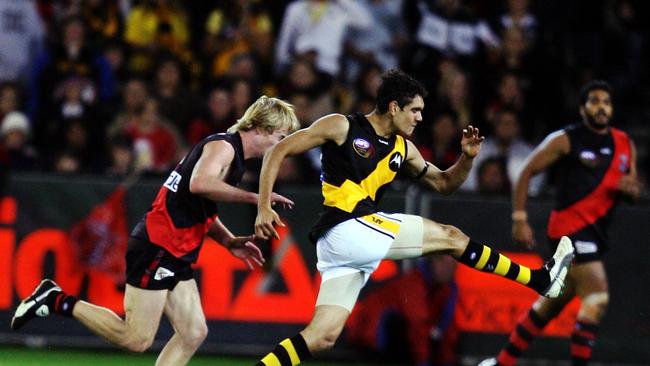Dreamtime at the ‘G might be postponed, but the impacts of the game are still evident according to current and former AFL stars
The Dreamtime at the ‘G clash would have been this weekend. But while this year’s edition might be on hold, the impact of the game has only continued to grow since its 2005 inception. Now some of the biggest names to have played share their stories.

AFL
Don't miss out on the headlines from AFL. Followed categories will be added to My News.
Andrew Krakouer can still remember the feeling.
It was July 9, 2005 and a Saturday afternoon clash at the MCG, Richmond meeting Essendon in the first so-dubbed “Dreamtime at the G” — a “thankyou”, then-Bombers coach Kevin Sheedy said, for indigenous players who had played the game and hoped it could become one of the great games of the AFL calendar.
Krakouer had completed a week of promotion alongside Bombers counterpart Dean Rioli, but there was only one feeling when he ran out in yellow and black.
“Extremely proud,” the former Tiger and Pie recalled to the Herald Sun.
“That’s the first thing that comes to mind. Just so proud that we had the opportunity to be able to represent our people in that round.
“After I played, I never went to one for years, because I was back in WA. I think it was 2018 that I went to another one. When I was playing, I didn’t see any of the pre-game, because I was in the changerooms getting ready, so to actually watch that and how the crowd got involved and the walk into the ground, it was absolutely amazing.”
Relive classic AFL matches from the 60s to today on KAYO SPORTS. New to Kayo? Get your 14-day free trial & start streaming instantly

It’s come “leaps and bounds”, Krakouer said.
Had the season continued as planned, Saturday night would have marked the 16th edition of the game, which he says has become “a great way to respect” players that have gone before.
“Every week they’d go out – and I’m coming at this from an indigenous perspective, but no doubt no different to any player – and represent themselves, their family, their loved ones and their culture. And the people that paved the path for them,” he said.
“I always felt that it was really important. For the footy clubs to be able to do that, and have our amazing Australian indigenous culture put on show for the nation to see. Being able to play in those games was another level. I was very fortunate to have played in the three that I did.”
THE ‘WHERE WERE YOU WHEN’ MOMENT
RICHMOND chief executive Brendon Gale was there that day, then working as a lawyer and invited as a guest to attend the first Dreamtime game and sit next to none other than club legend and Maurice Rioli.
The Tiwi product and two-time Tigers best and fairest winner was “a bit of a mythical figure” to Gale, who himself had played 244 games in yellow and black.
He has seen every Dreamtime game – there’s been 14 since the day he spent with Rioli, the first incarnation of an idea first floated by Phillip Wallbridge and those inside Richmond and further championed and pushed by Sheedy.
But his favourite memory came just last year, in a real “where were you when” moment.
Who could forget Sydney Stack, and the war cry that stopped football in its tracks?

“I had no idea he was going to do that,” Gale said.
“They do a rehearsal with the dancers at Punt Road for the last training session, for all the staff. And there was no indication he was going to do it. And when he did it, there was 80-odd thousand, a big game, bit of drizzle almost added to it, really. It was a great moment.
“We’ve got this mantra at the club – proud to be. Know who you are, and (be) proud to be who you are.
“It was just such a powerful symbol of that, and for him to say ‘this is me, this is my culture’ and to demonstrate that culture, it was really powerful. Really powerful.
“I think (Bomber) Tommy Bellchambers just stood there and took it.
“At the club, we heavily invest in this space – for our Korin Gamadji Institute and the work we do, we try and develop the next generation of indigenous leaders that determine their own futures. Most of the time, it’s got nothing to do with sport. But he’s a really powerful example of a guy celebrating his culture and demonstrating it for all to see. And people loved it.”
Stack, now resplendent with pink and purple “iso” hair, is always “a little bit extra”, according to teammate Shai Bolton, and didn’t hesitate to be photographed alongside teammate Daniel Rioli – who also holds the game dear – for the Herald Sun’s recognition of what would have been the 16th edition of Dreamtime at the G tonight, were it not for the effects of coronavirus on the game.

He told the Herald Sun last month that he was determined to “lift others”, and that culture is one of the most important aspects of his life.
The significance of the game to Richmond, Essendon and the wider indigenous community is immense, Gale said, with the game still to be recognised whenever it is played in 2020.
“It started as a recognition of the contribution of indigenous Australians to our game over time, and there has been many, and some of the all-time greats,” he said.
“It’s important because it really supports and promotes reconciliation between indigenous and non-indigenous Australians, and closing the gap in education and health and sport and football is a really important platform for that.
“A bit like a footy team, you’ve all got to work together, and the teams that work together are the best footy teams.”
LOVETT-MURRAY’S 200 TICKET ORDER
THEY came in busloads to watch Nathan Lovett-Murray in the Dreamtime game.
Literally.
The former Bomber recalls Dreamtime games as some of his most memorable, not only for the six that he played in but for the significance of the occasion and particularly for “the AFL’s acknowledgment of the past indigenous players, the trailblazers that went before us”.
In one – Lovett-Murray played Dreamtime games between 2005 and 2012 – saw a huge ticket order to fulfil the demands of those closest to him.
“There was one game where I got over 200 tickets to give to family, and a lot of them came from Heywood on big buses,” he said.
“I remember walking out onto the ground and doing the warm-up and seeing all the family in the crowd. That was something that was a real highlight for myself and being able to be a part of that.”

Lovett-Murray, who credits club great Michael Long for getting him to Essendon, now works as an indigenous player development manager at St Kilda and also has a documentary and schools education program in the works, focusing on Nicky Winmar’s famous stance against racism.
He says the indigenous player network not only rallied for that game, but continues to serve as a valuable community of mateship within the playing fraternity.
“We’ve got the brother boys, and we’re all pretty close,” he said.
Former teammate Courtenay Dempsey played in seven.
He’d lift for them, often circling the game that he held in similar esteem to Anzac Day.
“Dreamtime at the G is no different,” Dempsey said.
Dempsey now works with indigenous youth in education since leaving the Bombers at the end of 2016. He still holds Dreamtime memories close to his heart.
“To showcase the variety of our culture is something special, and to showcase it on such a big stage is even more wonderful,” he said.
“You run out there, and you’re running out there with your family, your culture and your community on your shoulders and you’re feeling 10 feet tall, because you’re out there representing all of that. You feel honoured and privileged to be a part of it.”
That wasn’t lost on Bolton, a premiership Tiger and player behind this year’s guernsey, whose first Dreamtime outing in 2017 was “crazy”.

“I’d never played in front of that much of a crowd in my life,” he laughed.
“It’s very important to me, and would be to most indigenous people. The club is just amazing with the way they look after us, too.”
INSIDE A DREAMTIME DEBUT
RICHARD Tambling celebrated early.
But debutant Tiger Jarrad Oakley-Nicholls had just wanted to get boot to ball.
Taken at pick 8 in the 2005 draft, the kid from East Perth found himself as an indigenous youth setting foot on the MCG for the first time in the Dreamtime game.
To debut in the iconic fixture was one point, but it was the one he kicked in the dying minutes that sealed the game.
“To debut on such an iconic fixture for the AFL was quite emotional but quite exciting. It just gave a little bit more purpose to that whole debut of a childhood dream, to do it on that day,” Oakley-Nicholls told the Herald Sun.
“It would have been nice to be a goal, but the crowd went wild.
“That was the last play pretty much of the game, and it was down in the back half for Essendon and Joel Bowden had the kick out, and had kicked the ball up the field, Andrew Kellaway got the ball on the wing and handballed it over to me and I was full flight and running to the top of 50.

“Had I pinged it, well … Richard Tambling started celebrating, thinking it was a goal. It was a long time ago, but it’s very fresh in my mind.”
Oakley-Nicholls, who played just 12 more games before a shift to West Coast where he didn’t play, recently established Oaks Civil Construction which also focuses on providing work for indigenous employees, said his one Dreamtime game was a culmination of years of work.
“My whole childhood, all I wanted to do was play AFL footy, and to debut on the MCG in the Dreamtime at the G game was huge, and such a significant day for me and my family,” he said.
THERE IS STILL MORE WORK TO BE DONE
KRAKOUER is the first to recognise that “we’ve come a long way”.
He’d like indigenous contribution to the game be recognised for more than just Sir Doug Nicholls Round – which would have been this weekend – and won’t be convinced there isn’t more work to be done until no AFL player is subjected to any kind of vilification, on any platform.
“I think about my father Jim and uncle Phil (who played in the 1980s) and what they had to go through when they played footy … I don’t know how they did it,” Krakouer said.
“Their mindset and their resilience is absolutely outstanding. I hear about some stories and I don’t know how I would have coped with that, but how they did and to still be able to play the footy that they did and perform at the level they did was an absolute credit to themselves.
MORE AFL
Richmond hero Marlion Pickett may work in juvenile justice system
“That’s no different to the blokes like Graham “Polly” Farmer, Maurice Rioli, and these guys who came through in the early years when there was hardly any indigenous players in the VFL/AFL system at that stage. Obviously we’re always trying to educate ourselves and be able to get better, and is it enough? It’s enough when none of our players are being sledged from supporters or social media.
“Yes, it’s a long way to go, but slowly but surely if we’re helping to educate people to understand that and to be able to celebrate this culture and do it more often than not, we’ll be all better off.”
Originally published as Dreamtime at the ‘G might be postponed, but the impacts of the game are still evident according to current and former AFL stars



